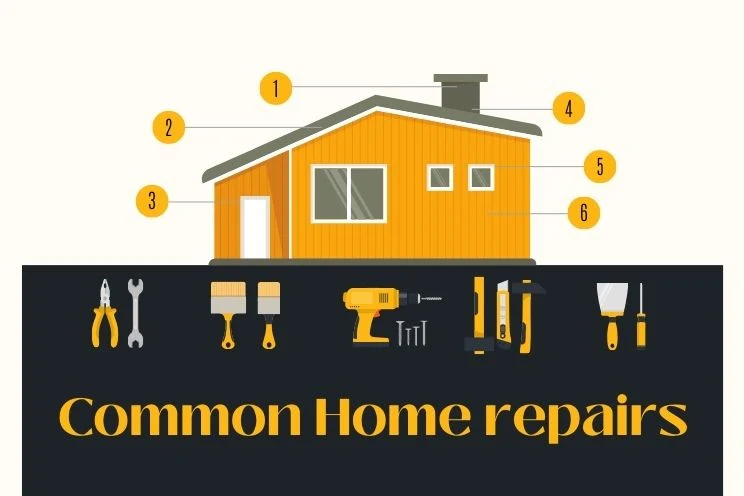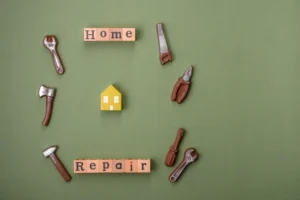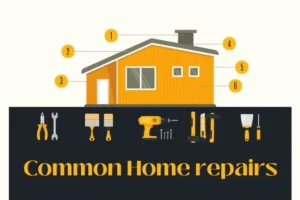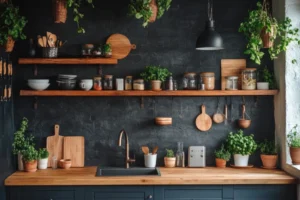Common Home Repairs: Essential Fixes Every Homeowner Should Know
Owning a home is rewarding, but it comes with responsibilities. Over time, houses experience wear and tear, leading to various common home repairs. Whether it’s a leaky faucet, an electrical issue, or a roofing problem, understanding these repairs can help homeowners save money and prevent further damage. Some issues are simple fixes, while others require professional intervention. Regular home maintenance can help prevent these common issues and keep your home in top condition.
This guide explores the most common home repairs, why they occur, and how to address them efficiently. By the end, you’ll have the knowledge to keep your home well-maintained and functional.
Common Home Repairs: 1. Plumbing Problems
Plumbing issues top the list of common home repairs. From slow drains to pipe leaks, plumbing problems can quickly escalate if not handled properly. Many plumbing repairs can be done for a few hundred dollars, making them cost-effective. Here’s what you need to know:
Leaky Faucets
A dripping faucet can waste gallons of water every day. This issue is usually caused by worn-out washers or seals, and can sometimes be exacerbated by high water pressure.
- To fix it, turn off the water supply, remove the handle, and replace the washer or O-ring. Additionally, wood filler can be used to secure any loose fixtures around the faucet area.
Clogged Drains
Clogged drains are often caused by hair, soap scum, or grease buildup. A plunger or a mixture of baking soda and vinegar can help dissolve minor blockages. For more stubborn clogs, a commercial drain cleaner can be used to dissolve the buildup. For persistent clogs, a drain snake may be required.
- Regular maintenance of the garbage disposal can help prevent clogs caused by food waste.
Running Toilets
If your toilet runs continuously, it may have a faulty flapper. Replacing the flapper is an inexpensive and quick solution that prevents water waste.
Preventing Water Damage
Preventing water damage is crucial to avoid costly home repairs. Waterproofing your basement and foundation can also help prevent water damage. Water damage can result from various sources, including leaks, floods, and appliance malfunctions. To prevent water damage, homeowners can take several steps:
- Inspect Pipes Regularly: Regularly check pipes for signs of damage or wear. Early detection of leaks can save money on extensive repairs.
- Fix Leaks Promptly: Address any leaks immediately to prevent water from causing further damage.
- Install Water Sensors: Water sensors can detect leaks early, allowing you to take action before significant damage occurs.
- Keep Gutters Clean: Ensure gutters are free of debris to allow proper water flow and prevent overflow that can damage your home.
- Install a Sump Pump: A sump pump can prevent basement flooding by removing excess water.
By taking these steps, homeowners can reduce the risk of water damage and save money on costly repairs.
Protecting Your Home’s Foundation
Protecting your home’s foundation is essential to prevent costly repairs. A home’s foundation is its base, and any damage to it can lead to structural issues and expensive fixes. To protect your home’s foundation:
- Ensure Proper Drainage: Make sure the ground around your foundation slopes slightly away from the house to keep water away.
- Clean Gutters and Downspouts: Clogged gutters and downspouts can lead to water pooling around the foundation. Keep them clean to prevent this.
- Use Downspout Extensions: Add extensions to downspouts to discharge water 5 to 10 feet away from the foundation.
- Inspect Regularly: Regularly check the foundation for signs of damage or wear, such as cracks or settling.
By taking these steps, homeowners can protect their home’s foundation and prevent costly repairs.
Essential Plumbing Tools
Having the right plumbing tools can help homeowners tackle minor plumbing issues and prevent costly repairs. Here are some essential plumbing tools to have:
- Adjustable Wrench: Useful for tightening and loosening pipes and fittings.
- Basin Wrench: Designed for reaching and tightening faucet mounting nuts in tight spaces.
- Channel-Type Pliers: Great for gripping and bending objects.
- Needle-Nose Pliers: Ideal for reaching and gripping small objects in confined spaces.
- Teflon Tape: Essential for creating a watertight seal on threaded pipes.
By having these essential plumbing tools, homeowners can tackle minor plumbing issues and prevent costly repairs.

2. Electrical Repairs
Electrical issues are another set of common home repairs that homeowners frequently face. Some minor fixes can be done independently, but safety is key. Updating light fixtures can enhance a home’s ambiance and address potential electrical issues.
Tripped Circuit Breakers
Overloaded circuits often cause breakers to trip. To fix this, unplug devices from the affected circuit and reset the breaker. If the problem persists, consult an electrician.
Dead Outlets
A dead outlet can be frustrating. Before calling an electrician, check if the outlet is connected to a GFCI (Ground Fault Circuit Interrupter) and try resetting it. If that doesn’t work, inspect the breaker panel and the electrical panel for any issues.
Flickering Lights
Loose wiring or faulty light bulbs can cause flickering lights. If changing the bulb doesn’t help, an electrician may need to inspect your wiring for safety concerns.
Replace a Light Switch
Replacing a light switch is a straightforward and cost-effective home repair that can be done with basic tools and materials. Whether you’re updating an old switch or fixing a faulty one, the process is simple and can be completed in a few steps.
First, ensure your safety by turning off the power to the switch at the circuit breaker. Use a voltage tester to confirm that the power is off. Next, remove the switch plate cover and unscrew the old switch from the electrical box. Carefully disconnect the wires from the old switch, noting their positions.
Install the new switch by connecting the wires to the corresponding terminals. For single-pole switches, connect the black (hot) wire to the brass terminal and the white (neutral) wire to the silver terminal. If you’re installing a double-pole switch, follow the manufacturer’s instructions for wiring. Secure the switch to the electrical box, replace the switch plate cover, and turn the power back on.
Regular maintenance, such as tightening loose screws and checking for signs of wear, can prevent electrical issues and extend the life of your light switches. By staying proactive, you can ensure your home’s electrical system remains safe and functional.
3. Roof Repairs
Your roof is your home’s first defense against the elements, making it essential to keep in good shape. Extreme heat can exacerbate roofing issues, making timely repairs crucial. Here are some common home repairs related to roofing:
Leaky Roof
A roof leak can cause serious interior damage. Using high-quality roofing materials can help prevent leaks and extend the life of your roof. Missing shingles, damaged flashing, or clogged gutters are common culprits. Fix minor leaks with roofing sealant, but extensive damage should be handled by a professional roofer. Addressing protruding nail heads can help prevent leaks and ensure roof stability.
Gutter Maintenance
Clogged gutters lead to water backup, which can damage your roof and foundation. Cleaning them regularly prevents these issues and ensures proper water drainage.
Replacing Missing Shingles
Strong winds and harsh weather can cause shingles to loosen or break. Replacing damaged shingles extends the life of your roof and prevents leaks.
4. Drywall and Ceiling Repairs
Drywall damage is another common home repair. Cracks, holes, and stains can affect the look and integrity of your walls and ceilings. Additionally, wood glue can be used to secure loose fixtures and ensure stability.
Patching Small Holes and Cracks
Minor holes from nails or screws can be patched with spackle. For larger cracks, use joint compound or drywall compound and sand it smooth before repainting.
Water Stains on Ceilings
If you notice a water stain on your ceiling, it’s likely from a plumbing or roof leak. Identifying the source and fixing it is the first step before repainting the ceiling.
5. Flooring Repairs
Your floors endure daily wear and tear, so maintaining them is crucial. Hardwood floors, in particular, are known for their durability and aesthetic appeal. Here are some common home repairs for different flooring issues:
Hardwood Floor Scratches
Minor scratches can be buffed out with wood polish, while deeper scratches may require refinishing or replacing boards. Additionally, wood glue and wood filler can be used to repair deeper scratches and secure loose boards. For extensive damage, it may be best to consult a professional flooring contractor.
Cracked Tiles
Replacing cracked tiles prevents further damage and maintains the aesthetic of your home. Use a chisel to remove the broken tile and apply new adhesive and grout.
Carpet Stains and Tears
Carpet stains can often be removed with a quality cleaner. Tears may need patching or professional repair to restore the carpet’s look.
Silence a Squeaky Floor
Squeaky floors can be a nuisance, but they can often be silenced with a few simple steps. The most common cause of squeaky floors is loose floorboards rubbing against each other or the joists below. Fortunately, you can address this issue with basic tools and materials.
One effective method is to drive screws into the floor joists. Start by locating the squeak and identifying the joist beneath the floorboard. Use a drill to drive a screw through the floorboard and into the joist, pulling the board tight and eliminating the squeak. Be sure to countersink the screw heads to avoid tripping hazards.
Another solution is to use wood glue to fill in the gaps between the floorboards and the joists. Apply a small amount of wood glue to the gap and press the floorboard down until the glue sets. This method can help secure loose boards and prevent future squeaks.
Regular maintenance, such as tightening loose screws and applying wood glue as needed, can keep your wood floors in top condition. By addressing squeaks promptly, you can extend the life of your flooring and enjoy a quieter home.
6. Window and Door Repairs
Drafty windows and sticky doors affect comfort and energy efficiency. Replacing old windows with vinyl windows can improve insulation and energy efficiency. Here’s how to address these common home repairs:
Fixing Drafty Windows
Weatherstripping or caulking around window edges can seal air leaks and improve energy efficiency. Additionally, replacing old windows with new vinyl windows can provide better insulation and reduce drafts.
Unsticking Doors
Humidity can cause wooden doors to expand. Sanding down the edges and applying a coat of paint or sealant can resolve the issue.

7. Exterior Home Repairs
Maintaining the exterior of your home improves curb appeal and prevents structural damage. Vinyl siding can enhance the aesthetic value and durability of a home. Here are some common home repairs to consider:
Repainting Faded or Peeling Paint
A fresh coat of exterior paint protects your home from moisture damage and gives it a refreshed look.
Driveway and Walkway Maintenance
Cracks in concrete or asphalt driveways should be sealed to prevent worsening over time. Extreme heat can cause asphalt driveways to deteriorate faster, making timely maintenance crucial.
Deck and Fence Repairs
Wooden decks and fences can become weak over time. Tightening loose boards and reapplying sealant can prevent future damage.
8. HVAC Maintenance
Your heating and cooling system is essential for comfort. Regular maintenance, especially of your air conditioner, can prevent costly repairs and ensure efficient cooling.
Replacing Dirty Air Filters
Changing air filters every few months improves air quality and efficiency.
Fixing a Noisy Furnace
Strange noises from your furnace could indicate worn-out parts. A professional inspection can identify and resolve the issue.
Air Conditioning Troubleshooting
If your AC isn’t cooling properly, cleaning the coils and checking refrigerant levels can help restore efficiency.
Regular maintenance of the air conditioner can prevent issues and extend its lifespan. If issues persist, it may be necessary to consult a professional HVAC technician.
9. Appliance Repairs
Appliance repairs can be a significant expense, but regular maintenance can help prevent breakdowns and extend the life of your appliances. By performing simple repairs and maintenance tasks, homeowners can save money and avoid the need for costly professional services.
For example, replacing a faulty thermostat in your oven or refrigerator can often be done with basic tools and a replacement part. Similarly, cleaning a clogged drain in your washing machine or dishwasher can restore proper function and prevent water damage.
However, some repairs, such as fixing a malfunctioning air conditioner or repairing a gas appliance, may require the expertise of a professional. It’s important to know your limits and call in a qualified technician when necessary to ensure safety and compliance with local codes.
Regular maintenance, such as cleaning filters, checking for leaks, and inspecting electrical connections, can help prevent appliance issues and extend their lifespan. By staying proactive, homeowners can save money and keep their appliances running smoothly.
Fix a Smelly Dishwasher
A smelly dishwasher can be unpleasant, but it’s often an easy fix. The most common cause of dishwasher odors is a buildup of food particles, grease, and soap scum. Regular cleaning and maintenance can prevent these issues and keep your dishwasher smelling fresh.
Start by cleaning the dishwasher filter. Remove the filter and rinse it under hot water to remove any debris. Next, run a cleaning cycle with a dishwasher cleaner or a mixture of vinegar and baking soda. This will help break down grease and food particles and eliminate odors.
Check the dishwasher drain to ensure it’s clear of clogs. A clogged drain can cause water to stagnate and create unpleasant smells. If necessary, use a drain snake or a mixture of baking soda and vinegar to clear the blockage.
Regular maintenance, such as cleaning the filter and running a cleaning cycle every few months, can prevent odors and extend the life of your dishwasher. By staying proactive, you can keep your dishwasher running efficiently and your kitchen smelling fresh.
9. Pest Prevention and Control
Pests can cause extensive damage to a home if not addressed promptly. Common pests include termites, rodents, and ants. Maintaining cabinet doors can help prevent pests from accessing food and nesting in the kitchen.
Termite Damage
Termites can weaken wooden structures. Regular inspections and professional treatments can prevent infestations.
Rodent Control
Mice and rats can chew through wires and insulation. Sealing entry points and using traps can keep them out.
Ant Infestations
Ants often invade kitchens. Keeping surfaces clean and sealing entry points can deter them.
When to Call a Professional
While many common home repairs can be handled as DIY projects, some require expert help. Electrical work, major plumbing repairs, and roof replacements should always be done by licensed professionals to ensure safety and compliance. Proper planning and budgeting for a home improvement project can help avoid overspending and ensure successful completion.
Final Thoughts: Keep Your Home in Top Shape
Understanding common home repairs helps homeowners tackle minor issues before they escalate. Regular maintenance can prevent costly damage and keep your home in excellent condition. By addressing problems early, you save time and money while maintaining your home’s value.
If you need professional help, Steadfast Construction is here for you! Our experienced team offers expert home improvement and repair services tailored to your needs. Visit https://steadfastconstructionwi.com/ to learn more.
Stay connected with us on Facebook for updates, expert tips, and home maintenance insights. Let us help you keep your home in top shape!
FAQs
1. How can I prevent basement flooding?
Basement flooding can be prevented by ensuring proper drainage around your home, cleaning gutters regularly, installing a sump pump, and sealing foundation cracks. Checking for plumbing leaks and ensuring downspouts direct water away from the foundation can also help.
2. What are the best ways to prevent wood rot on exterior structures?
To prevent wood rot, keep wooden surfaces sealed with paint or stain, ensure proper ventilation, and avoid prolonged water exposure. Regularly inspect decks, fences, and siding for early signs of decay and replace or repair affected areas promptly.
3. Why does my garage door get stuck, and how can I fix it?
Garage doors can get stuck due to misaligned tracks, broken springs, or dirt buildup. Regularly lubricating the tracks, checking for obstructions, and tightening loose hardware can help prevent this issue. If the problem persists, a professional may be needed for spring replacements. Addressing stripped or enlarged screw holes can ensure the garage door hardware remains secure. If the problem persists, it may be necessary to inspect the garage door opener for any issues.
4. How do I stop pests from entering my attic?
To prevent pests in your attic, seal all potential entry points, including gaps in the roof and vents. Keep trees and shrubs trimmed away from the house, store food in airtight containers, and set up pest deterrents like traps or ultrasonic repellents.
5. Why do my interior walls develop condensation?
Condensation on walls occurs due to high indoor humidity and poor ventilation. Running a dehumidifier, using exhaust fans in kitchens and bathrooms, and ensuring proper insulation can reduce moisture buildup and prevent mold growth.
6. How do I fix a door that won’t latch properly?
If a door won’t latch, check for loose screws on the hinges and ensure the door is properly aligned. If needed, adjust the strike plate slightly using a screwdriver to help the latch fit correctly.
7. What is the best way to maintain exterior brickwork?
Regularly clean brick surfaces with a soft brush and mild detergent to remove dirt and moss buildup. Repair any cracked or missing mortar with tuckpointing to prevent water penetration and structural weakening.
8. How do I prevent ice dams on my roof in winter?
Ice dams form due to poor attic insulation and ventilation. Prevent them by ensuring your attic has proper airflow, sealing any air leaks, and keeping gutters clear of debris before snowfall.
9. What should I do if my chimney has cracks?
Chimney cracks can lead to leaks and structural damage. Small cracks can be sealed with waterproof chimney sealant, but larger cracks may require a professional mason to repair them safely.
10. How can I tell if my home’s insulation needs an upgrade?
If your home has uneven heating, high energy bills, or drafts, it may need better insulation. Inspect attic insulation levels and consider upgrading to energy-efficient materials like spray foam or fiberglass batts for better temperature regulation.
















